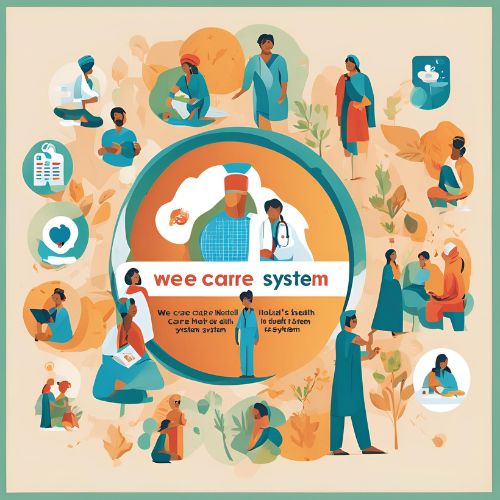
India’s health system, a crucial pillar for the nation’s progress, has been under scrutiny for years. With a vast population and diverse socio-economic conditions, the effectiveness and efficiency of the health care system in India are vital for the country’s development. This article delves into the complexities of India’s health system, evaluating its current state, challenges, and the efforts being made to improve it.
🏥 Understanding India’s Health System
🌐 Overview of the Health Infrastructure
India’s health system is a mix of public and private health care services. The public health system, managed by the government, includes primary health centers (PHCs), community health centers (CHCs), district hospitals, and tertiary care hospitals. The private sector, which comprises a significant portion of the health care services, includes hospitals, clinics, and individual practitioners.
💡 Health Care Services
The range of health care services in India includes preventive, promotive, curative, and rehabilitative care. These services are delivered through a network of health facilities and health professionals, including doctors, nurses, and allied health workers.
📊 Current State of India’s Health System
📉 Key Health Indicators
India has made significant strides in improving health indicators over the years. Life expectancy has increased, infant mortality rates have decreased, and there is better control of infectious diseases like polio and tuberculosis. However, the country still faces challenges such as high maternal mortality rates, malnutrition, and a rising burden of non-communicable diseases (NCDs).
🚑 Accessibility and Availability
Despite improvements, accessibility and availability of health care remain uneven across the country. Urban areas often have better health facilities and services compared to rural and remote regions, where health infrastructure is inadequate and understaffed.
💸 Health Expenditure
India’s health expenditure as a percentage of GDP is relatively low compared to other developing countries. This underfunding affects the quality and reach of health services, leading to out-of-pocket expenses for patients, which can be a significant financial burden.

🌟 Major Challenges in India’s Health System
👥 Population and Demographic Pressure
India’s large and growing population puts immense pressure on the health system. The increasing population density, particularly in urban areas, strains existing health infrastructure and resources, making it challenging to provide timely and adequate health care services.
🏥 Infrastructure Deficiency
The lack of adequate health infrastructure, particularly in rural areas, is a significant challenge. Many health facilities are under-resourced, lacking essential equipment, medicines, and trained health personnel. This results in substandard care and poor health outcomes.
👩⚕️ Human Resource Shortage
There is a critical shortage of health care professionals in India. The doctor-to-patient and nurse-to-patient ratios are far below the recommended levels, leading to overburdened health workers and compromised patient care.
💊 Access to Medicines
Access to essential medicines is another pressing issue. Although India is known as the “pharmacy of the world” due to its large pharmaceutical industry, many people, especially in rural areas, still struggle to access affordable and necessary medications.
🏭 Non-Communicable Diseases (NCDs)
The rising prevalence of NCDs such as diabetes, hypertension, and cardiovascular diseases poses a new challenge to the health system. These chronic conditions require long-term management and significant health care resources, adding to the existing burden of communicable diseases.
🛠️ Efforts to Improve India’s Health System
📈 National Health Mission (NHM)
The National Health Mission (NHM) is a flagship program aimed at strengthening health care infrastructure and improving health outcomes. It focuses on providing affordable and quality health care to rural and underserved populations through various initiatives and schemes.
💉 Universal Health Coverage (UHC)
India has committed to achieving Universal Health Coverage (UHC) to ensure that all individuals have access to quality health services without financial hardship. Programs like Ayushman Bharat aim to provide health insurance coverage and improve health infrastructure at the grassroots level.
📚 Health Education and Awareness
Improving health education and awareness is crucial for enhancing health outcomes. Various government and non-governmental organizations are working to promote health literacy, encouraging preventive health measures and early detection of diseases.
🌐 Digital Health Initiatives
Digital health initiatives, such as telemedicine and electronic health records, are being implemented to improve accessibility and efficiency of health care services. These technologies can bridge the gap between urban and rural health care, providing remote consultations and better health data management.
🏥 Public-Private Partnerships (PPPs)
Public-Private Partnerships (PPPs) are being leveraged to enhance health infrastructure and service delivery. Collaborations between the government and private sector can bring in additional resources, expertise, and innovation to improve health care accessibility and quality.
📋 Policy and Governance
🏛️ Government Policies
The Indian government has introduced various policies and reforms to strengthen the health system. These include the National Health Policy, which outlines strategies for improving health care delivery, and the establishment of institutions like the National Health Authority to oversee health programs.
📜 Regulatory Framework
A robust regulatory framework is essential for maintaining standards and ensuring quality in health care. The government has implemented regulations for health care facilities, pharmaceuticals, and medical devices to safeguard public health.
🤝 International Collaborations
India engages in international collaborations and partnerships to enhance its health system. These collaborations bring in global best practices, technical assistance, and financial support to address health challenges effectively.
📊 Measuring the Impact
📅 Health Outcomes
Measuring the impact of health initiatives is crucial for assessing progress and identifying areas for improvement. Regular health surveys and studies provide data on key health indicators, helping to evaluate the effectiveness of health programs and policies.
💬 Community Feedback
Community feedback is vital for understanding the real-world impact of health services. Engaging with communities and gathering feedback helps in identifying gaps and ensuring that health services meet the needs and expectations of the population.
🔄 Continuous Improvement
Continuous improvement is a fundamental principle of a robust health system. Regularly reviewing and updating health policies, adopting new technologies, and training health care professionals are essential for adapting to changing health needs and challenges.
🌏 Conclusion: Do We Care About India’s Health System?
🌟 Summary of Findings
India’s health system faces significant challenges, including infrastructure deficiencies, human resource shortages, and a dual burden of communicable and non-communicable diseases. However, there have been considerable efforts to address these issues through government initiatives, public-private partnerships, and digital health innovations.
✅ Final Verdict
Do we care about India’s health system? The answer is complex. While there is a clear commitment from the government and various stakeholders to improve health care services, much more needs to be done to ensure that every individual has access to quality health care. Continuous investment, innovative solutions, and a collective effort from all sectors of society are essential for building a resilient and effective health system in India.
🌐 Call to Action
As individuals and communities, we must advocate for better health care services and support initiatives aimed at strengthening the health system. By staying informed, participating in health programs, and providing feedback, we can contribute to the improvement of India’s health care landscape and ensure a healthier future for all.



















